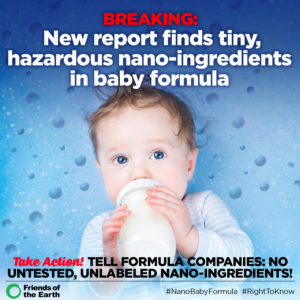Today, Friends of the Earth (FoE) US released a report on ‘Nanoparticles in Baby Formula’ revealing that popular infant formulas sold throughout the United States contain engineered nanomaterials. FoE tested a selection of six baby formula samples gathered from retailers in the San Francisco Bay Area, California. In all six of the baby formulas, nano-sized structures and particles of potential concern were found, including: nano-hydroxyapatite in needle-like and non needle-like form, iron oxide spherical nanoparticles, nano titanium dioxide, and nano silica dioxide – nano TiO2 and nano silica results were inconclusive.
 Recent studies summarized in the report, demonstrate that these nanomaterials may pose risks to human health if ingested or inhaled. The products therefore provide a probable inhalation hazard for babies, parents, and other caregivers, as well as workers involved in the manufacturing of these products, as well as possible risks from ingestion for babies.
Recent studies summarized in the report, demonstrate that these nanomaterials may pose risks to human health if ingested or inhaled. The products therefore provide a probable inhalation hazard for babies, parents, and other caregivers, as well as workers involved in the manufacturing of these products, as well as possible risks from ingestion for babies.
‘Nanomaterials have unique properties that offer many new opportunities for food industry applications. They can be used as nutritional additives, flavoring and coloring, anti-caking agents, or as antibacterial ingredients for food packaging. However, the same properties exhibited at the nanoscale that make these materials attractive for use in the food industry may also result in greater toxicity for humans and the environment.’
In relation to nano-hydroxyapatite which was found in three of six baby formulas, the EU Commission’s Scientific Committee on Consumer Safety (SCCS) published an opinion in October 2015, stating, “The available information indicates that nano-hydroxyapatite in needle form is of concern in relation to potential toxicity. Therefore, needle-shaped nano-hydroxyapatite should not be used in cosmetic products.” A material that should not be used in cosmetic products raises even greater concern for use in food products, especially if sold in powder form, increasing risks of inhalation.
 These findings can be linked to broader concerns regarding nanomaterials. Due to the lack of internationally recognized standards and measurement methods and a lack of transparency of the nanotechnology industry, there are significant challenges to understand where engineered nanoparticles are being used, what the potential routes of exposure are, and the toxicological endpoints.
These findings can be linked to broader concerns regarding nanomaterials. Due to the lack of internationally recognized standards and measurement methods and a lack of transparency of the nanotechnology industry, there are significant challenges to understand where engineered nanoparticles are being used, what the potential routes of exposure are, and the toxicological endpoints.
EU regulators have taken small steps to regulate the use of nanomaterials in food by requiring the labelling of pre-packed food containing engineered nanomaterials since December 2014 (article 55). In addition, as of January 1, 2018, specific authorization will be required for engineered nanomaterials before being used in food (articles 6 and 36). However, although it may look good on paper, these regulations are not adequate. There are serious flaws in the regulations, and the definition used, for example, makes implementation very difficult. The definition used in the regulations is vague and with a narrower scope than the one suggested by the Commission in its recommendation on definition of nanomaterial from 2011. The definition is even farther from the European Food Safety Authority’s recommendation, which suggests that the definition of engineered nanomaterial be more stringent than the Commission’s recommendation for the food business industry. The definitions set out in the regulations are therefore limiting the scope and impact of nano-specific provisions, allowing a large number of nanomaterials to fall outside the scope of the regulations. Furthermore, the regulations do not cover manufacturing processes, creating another gap and limiting the applicability of the regulations.
Another weakness making implementation a challenge is that the manufactures are themselves responsible for verifying whether or not the food, which they intend to place on the market, contains nanomaterials falling within the definition and scope of the regulations. The vagueness of the definition combined with this self-regulatory approach of implementation makes it easy for manufactures to avoid the nano-specific regulations. As a result, and, to the best of our knowledge, the labelling provisions for nano food are not being implemented at all.
The effective implementation of nano-specific regulatory provisions, including labelling, would require a serious commitment to enforcement by authorities. Thus far, this kind of commitment seems to be lacking as demonstrated by the lack of enforcement of nano specific provisions of other, older sectorial regulations, eg. the Cosmetics Regulation, in force since July 2013. Pursuant to Article 16(10) of the Cosmetic Regulation, the Commission should have published a catalogue of all nanomaterials used in cosmetics placed on the market by January 2014. However, to date, the Commission has not published such catalogue. The Commission has declared that this is due to inconsistent notification of cosmetics containing nanomaterials received by the industry, making the publication of a catalogue impossible. However, the Commission has not taken the initiative, such as by preventing products from being marketed until complete notification has been received, to adequately enforce the implementation of the Regulation. This shows that despite the legally binding character of the Cosmetics Regulation, implementation and enforcement are key in ensuring the health and safety of the public and the environment.
Originally posted May 17, 2016
